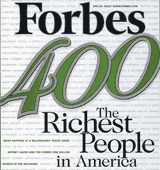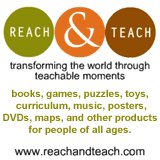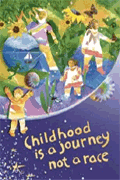(ref: Forbes 400, forbes.com. GDP data from 2010 CIA Factbook)
The total worth of the 400 wealthiest in the United States rose to $1.53 trillion. Numbers in [brackets] are countries with the closest approximate GDP. 
- Bill Gates ($59.0 bil; 55 yo; Medina, Washington; Microsoft) [Lebanon, Tanzania]
- Warren Buffett ($39.0 bil; 81 yo; Omaha, Nebraska; Berkshire Hathaway) [North Korea]
- Larry Ellison ($33.0 bil; 67 yo; Woodside, California; Oracle) [Paraguay]
- Charles Koch ($25.0 bil; 75 yo; Wichita, Kansas; diversified) [Trinidad, Estonia]
- David Koch ($25.0 bil; 71 yo; New York, New York; diversified) [Trinidad, Estonia]
- Christy Walton ($24.5 bil; 56 yo; Jackson, Wyoming; Wal-Mart) [Estonia]
- George Soros ($22.0 bil; 81 yo; Katonah, New York; hedge funds) [Georgia]
- Sheldon Adelson ($21.5 bil; 78 yo; Las Vegas, Nevada; casinos) [Mozambique]
- Jim Walton ($21.1 bil; 63 yo; Bentonville, Arkansas; Wal-Mart) [Mozambique]
- Alice Walton ($20.9 bil; 61 yo; Fort Worth, Texas; Wal-Mart) [Zambia, Macedonia]
- S. Robson Walton ($20.5 bil; 67 yo; Bentonville, Arkansas; Wal-Mart) [Zambia, Macedonia]
- Michael Bloomberg ($19.5 bil; 69 yo; New York, New York; Bloomberg LP) [Madagascar]
- Jeff Bezos ($19.1 bil; 47 yo; Seattle, Washington; Amazon.com) [Madagascar]
- Mark Zuckerberg ($17.5 bil; 27 yo; Palo Alto, California; Facebook) [Nicaragua, Chad]
- Sergey Brin ($16.7 bil; 38 yo; Los Altos, California; Google) [Mali]
- Larry Page ($16.7 bil; 38 yo; Palo Alto, California; Google) [Mali]
- John Paulson ($15.5 bil; 55 yo; New York, New York; hedge funds) [Papua New Guinea]
- Michael Dell ($15.0 bil; 46 yo; Austin, Texas; Dell) [Papua New Guinea]
- Steve Ballmer ($13.9 bil; 55 yo; Hunts Point, Washington; Microsoft) [Benin, Malawi]
- Forrest Mars ($13.8 bil; 80 yo; Big Horn, Wyoming; candy) [Benin, Malawi]
Net worth of the 20 wealthiest Americans for 2011: $459.2 billion [Pakistan].The net worth of the 400 wealthiest Americans was $1.53 trillion [the GDP of Mexico or the combined total GDP of Chile, Ghana, Ethiopia, Egypt, Saudi Arabia] or 10.4% of the $14.66 trillion GDP of the United States .
Check out Teaching Economics as if People Mattered – Born on Third Base for an interesting lesson plan about wealth and the Forbes 400.
Here’s a link to the 2009 list of the 20 Richest People in the US.
Filed under: Lists | Tagged: economic justice, economics, forbes 400, forbes400, justlists, wealth | Leave a comment »





